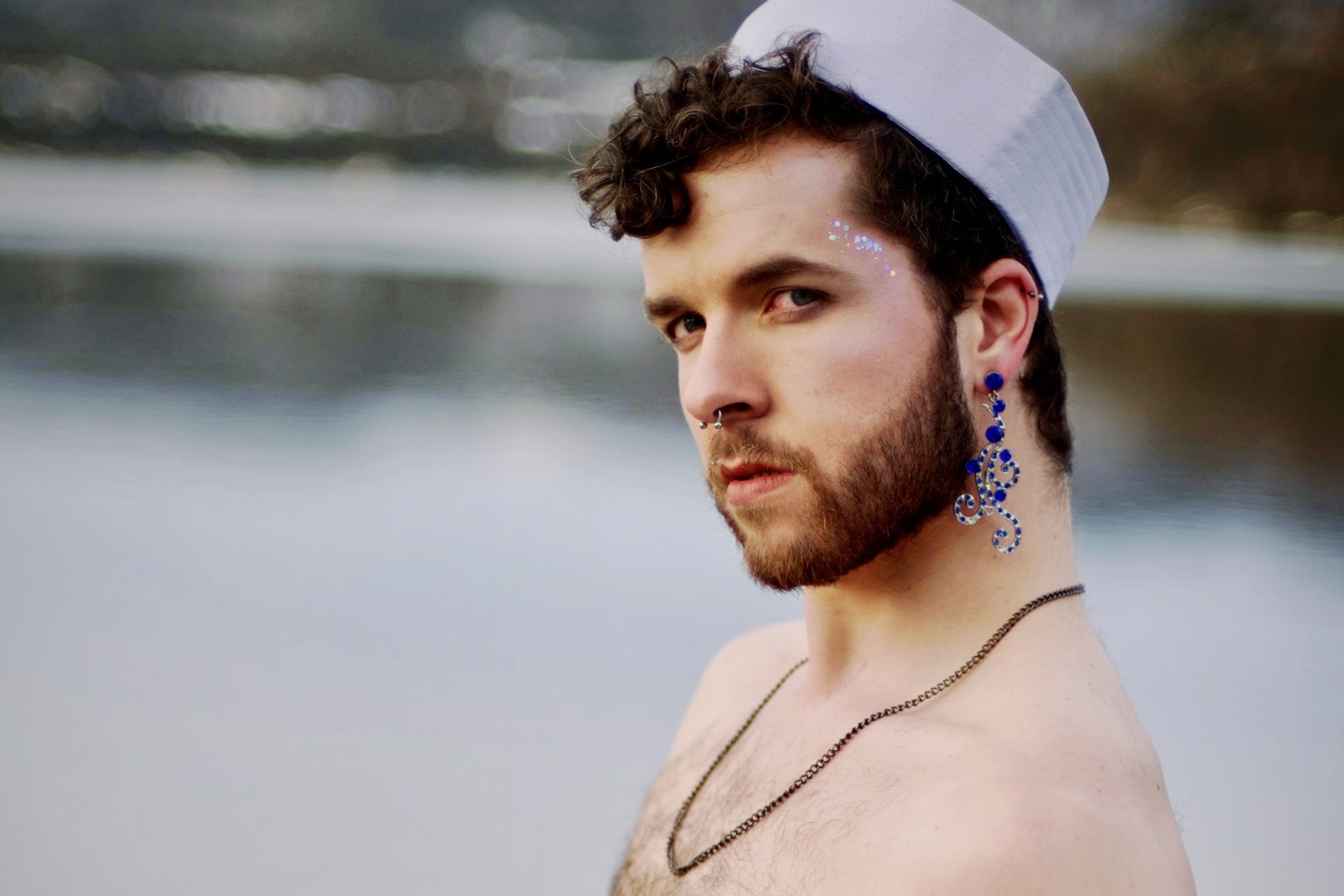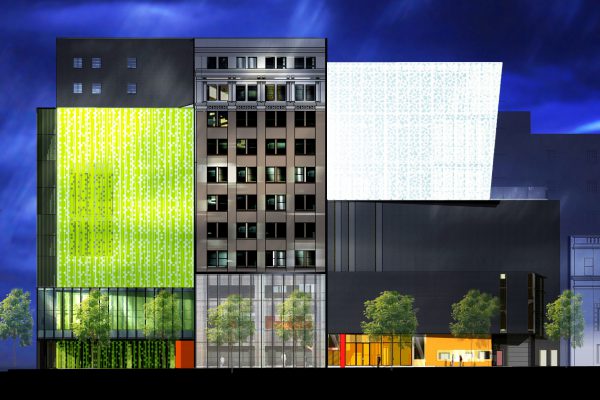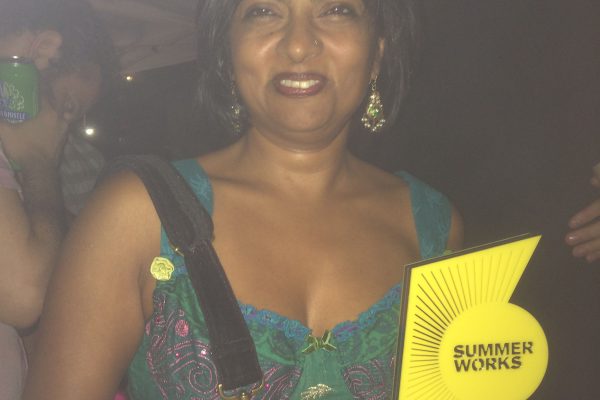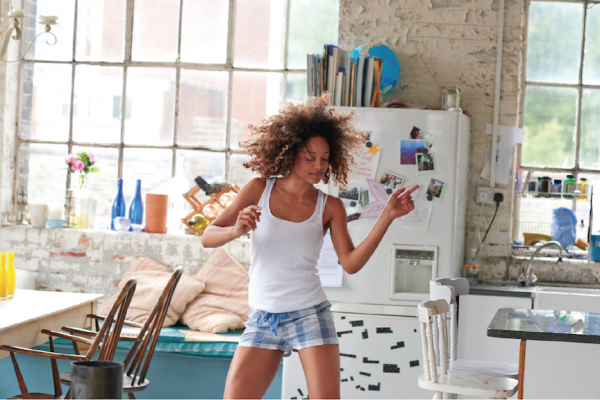This article was originally published in the Winter 2022 print issue.
Aug. 24, 2020. I’m posed behind a Plexiglas wall with a metal tips bucket out of my reach and my mask off to the side. I’m at Flash, a gay bar in Toronto, performing live for the first time during the pandemic and my last performance in the city for the foreseeable future. The music starts: Candyman by Christina Aguilera. I begin dancing, stripping and entertaining, and quite honestly, I’m off my game. A little shaky. It’s been five months since I last performed live. When I’m done, I yield the stage to my fellow performer, Toronto drag queen Tash Riot, and head upstairs to change. I put on a black leather jacket and thigh-high boots and return with a degree of “Screw it. What do I have to lose?” S&M by Rihanna kicks in. I start lip-synching during my burlesque number, somewhat of a taboo in certain burlesque circles, but it was the right choice for that performance. The rush of live performance sweeps me away. My tearaway pants accidentally find their way to the top of the Plexiglas wall, and I triumphantly tear them down on an appropriate musical beat. I’m back in the zone and feeling like myself. This is what I live for.
I’m a burlesque performer first and foremost. Onstage, I go by Newfound Lad and I can often be found playing into nautical themes, riffing on stereotypes of my home province and wearing a pair of heels. I like to consider myself drag adjacent, meaning you can usually find me standing next to a drag performer. After I finished my BFA in dance from York University, burlesque became a part of my artistic practice when I joined Toronto’s Boylesque TO. Before burlesque, I had always thought I would be a drag queen but lacked the makeup skills and general interest to learn them. But then, joining burlesque as an assigned-male-at-birth entertainer, I quickly learned that makeup, costuming and all of the work that goes along with it were just as important in this art form. I was in too deep at this point, touring internationally with an acclaimed troupe. I had to learn some skills and professionalize my craft.
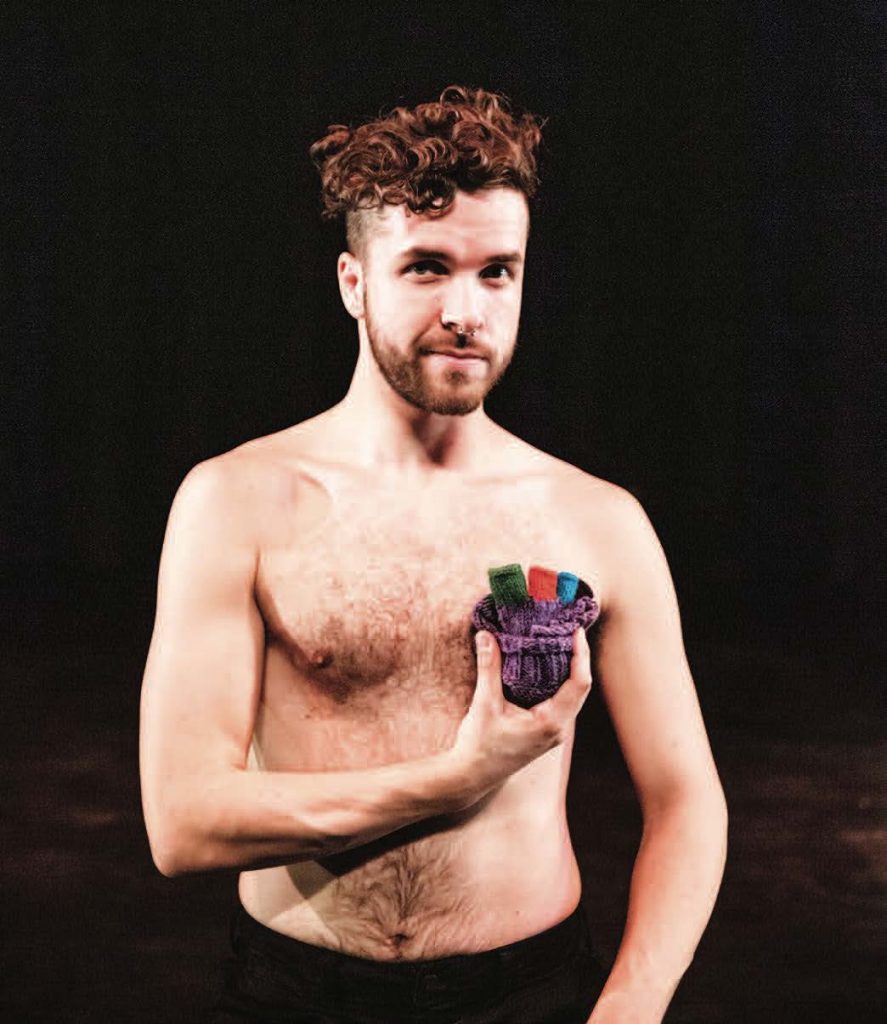
With an interest in diversifying my skills and learning more about makeup, I started working closely with drag performers by entering the second Absolut Empire’s Ball, an inclusive team drag competition created by Scarlett BoBo, a finalist on the first season of Canada’s Drag Race. I joined a team of drag kings, gender performers and a burlesque performer (oh wait, that’s me). We made up Rebel Gen, rebelling against the norm, the mainstream, and we won the whole thing. Our victory was a major departure from the team of drag queens that won previously, as well as the drag queen-focused media and competitions like RuPaul’s Drag Race, which solely showcase drag queen talent. After this competition, I began gaining traction in spaces I hadn’t accessed as a burlesque performer before. I was now on the fringe of drag and eager to learn more. Then came March 2020 and COVID-19.
One week after my August 2020 performance at Flash, I find myself home just outside of Corner Brook, N.L., on the first day of my two-week quarantine that was required to travel into the Atlantic bubble. No contact or sharing space with other humans and no hugs from my parents were allowed. I filled my quarantine playing hours of video games, filming myself doing TikTok dances in my mom’s backyard and watching the Canada’s Drag Race finale on Zoom with my friends. I had made the painstaking decision to move home to Newfoundland amidst the pandemic, fuelled by lack of employment and the cost of living in Toronto. During a phone call shortly before I made this choice, my mentor and friend Candice Pike told me, “It is OK to make a choice that makes you feel luxurious, that makes you feel safe, that makes you feel excited.” For the first time since I came to Toronto in 2013, it no longer made sense for me to be there. Nothing was changing any time soon, and I was in a place where I was able to let go of the city for that moment. The luxurious choice was to go home. I resolutely told myself I would spend the fall in and around Corner Brook and then be out of there. (Spoiler alert: I stayed for 11 months.) I truly never thought I’d live there again, but the comfort of home and a guaranteed job teaching at my old dance studio kept me there for longer than I expected.
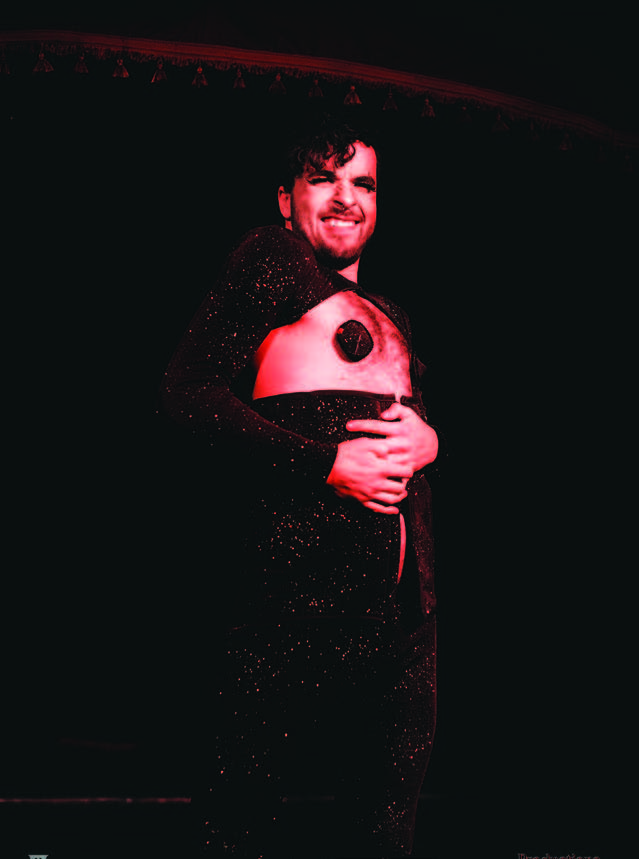
For some Newfoundland context, Corner Brook is a city of just under 20,000 people, and it’s a solid seven-hour drive to the nearest “big city,” St. John’s, and the nearest Queer space, Velvet Club & Lounge. Since moving, I wanted to pick up where I left off on the fringes of drag. I was hungry to see and know more. I knew there was a thriving drag community in St. John’s who I had yet to encounter and who aren’t being witnessed on a grander scale, a scale worthy of the quality of their work. On the national stage, we have one of the new franchises of RuPaul’s Drag Race, the previously mentioned Canada’s Drag Race. At the time of this writing, the cast of Season 2 has been revealed and we’re days away from the premiere. This season represents drag from British Columbia to as far east as Quebec, a slight improvement from Season 1 but still disappointing for East Coast drag fans. Touring across this country has taught me that drag, burlesque and Queer art can happen anywhere. So I took it upon myself to witness the work happening here and see what isn’t being showcased as “the best of drag” from coast to coast. I want to know about the drag these artists practise, what it’s like to perform drag on The Rock and, hopefully, learn more about my own work along the way.
Barbra Bardot
January 2021 came faster than I could have imagined, and it was time I found myself back onstage and amid the Queer community. Enter Barbra Bardot. Bardot is what I would call your quintessential drag queen. She can dance, she can lip-synch, she has big hair, she loves musical theatre, Cher and Celine. Need I say more? I knew Bardot back in Toronto as Jacques, a friend of my ex-partner and someone I occasionally saw at drag shows and parties. A Sheridan musical theatre graduate as well as an educator, she found herself in Toronto missing the stage. Luckily, a friendship with a local queen turned into a drag mother/daughter situation and Bardot was born.
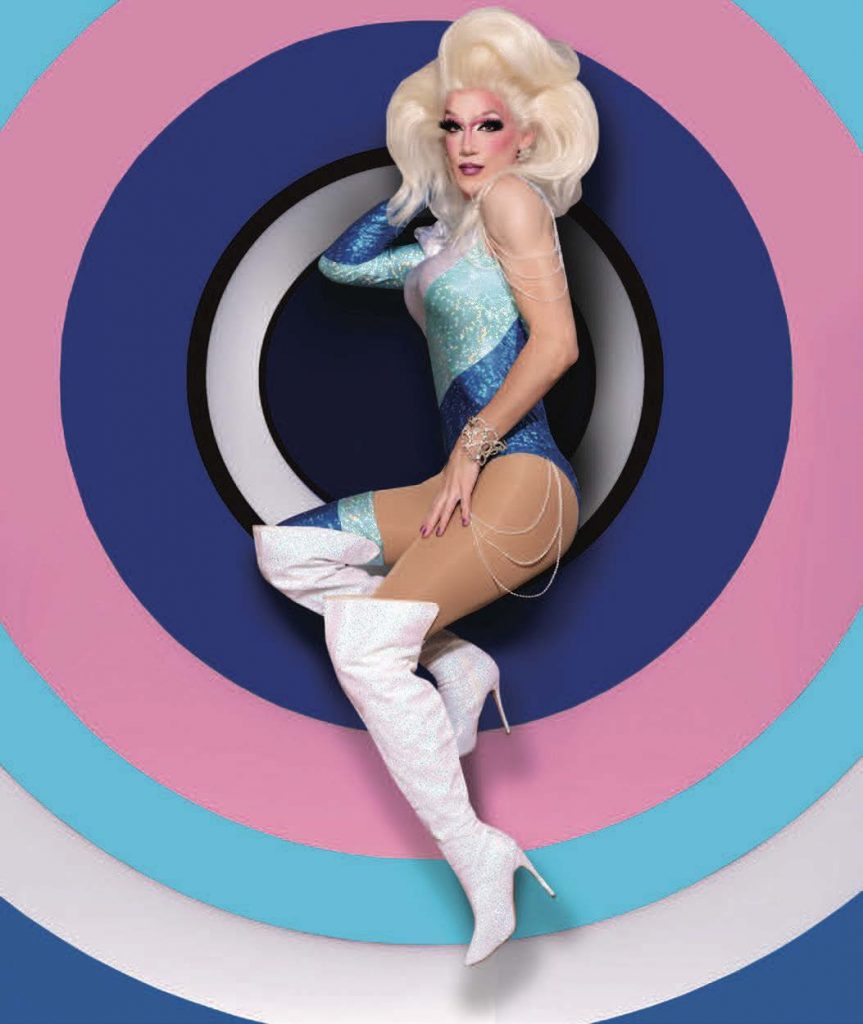
Bardot just so happens to be in a relationship with a Newfoundlander and in August of 2020 drove across the country and relocated to St. John’s. Moving to Newfoundland, she never imagined she would perform as much as she does now. She’s a staple in the St. John’s scene, hosting pride events and performing in different communities around the island. “It’s a pretty gay-ass place in Newfoundland,” she says. These are words that would have scandalized 16-year-old me. She found her community in Newfoundland through drag, through performing and in a place where, in her words, her star can shine a bit brighter. “I had dreams of being a superstar in musical theatre, but I’m so much happier and fulfilled doing this,” she says. Bardot sees the value in smaller communities like St. John’s where they can have a group chat on Facebook and support and know other community members more easily and more intimately. Bardot is proving you don’t have to be from Newfoundland to make it your home, and you can be a superstar anywhere. Bardot lights up a stage wherever she is, but she’s made a conscious choice to do it in Newfoundland. In conversation, she struck me with a statement about something I’m questioning to this day. She said, “People always ask me if I would go back, and I can’t ever see that happening. I love it here and I love my place in the community.” Would I go back? I don’t know.
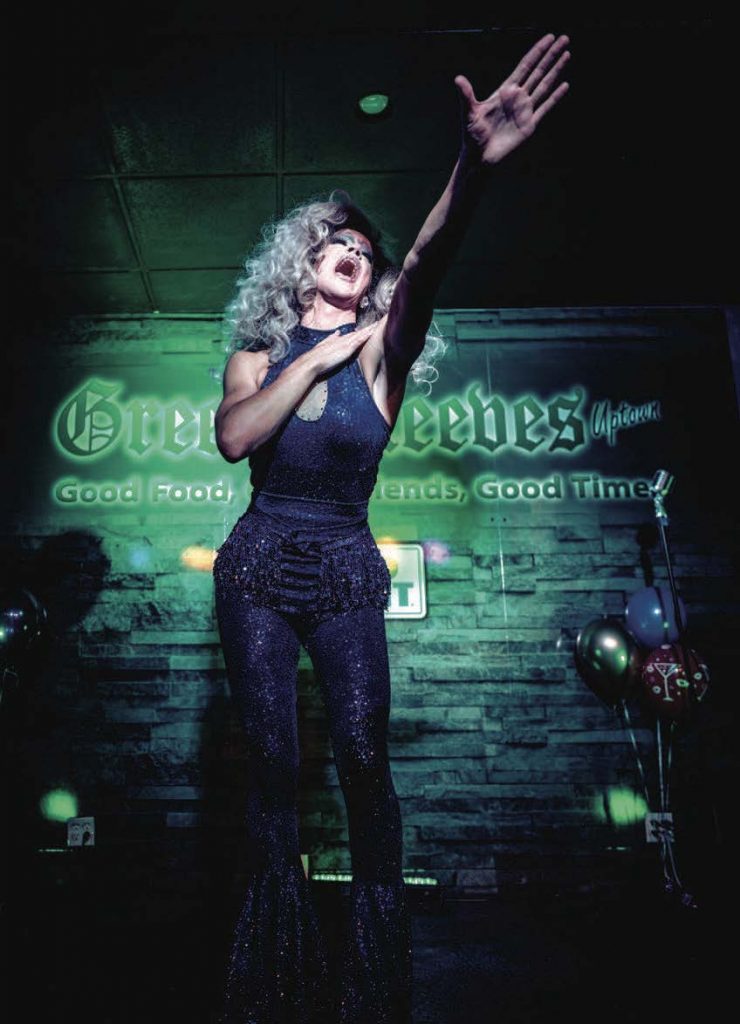
Let’s flip back to Corner Brook: at this point I’m itching for an opportunity to be onstage in a Queer space, so Bardot invited me to come to St. John’s and do a drag show with her and some local performers at Velvet. I drummed up some contemporary dance work to make the seven-hour drive plus weekend trip worthwhile, and I drove across the island to do my first show amid the St. John’s drag community. Bardot was one of the only drag performers I knew about. I’d never spent extended time in St. John’s growing up, and as an adult, I’d only been there for work.
People always ask me if I would go back [to Toronto], and I can’t ever see that happening. I love it here and I love my place in the community.
Bardot
It’s Jan. 10, 2021. My first show since I moved home. As a burlesque performer, I immediately feel included in ways I seldom witnessed or felt in Toronto. Unlike my final show in Toronto, song after song, performance after performance, I’m on fire, burning across the stage. I’m in a space full of Queer people; I’m dancing, stripping and lip-synching, doing my burlesque with some drag influence peppered in and being received and celebrated. Much like the province, this bar has plenty of room. There’s a luxury of space with pockets of Queers set up in cabaret-style seating throughout the bar. It’s a smaller community, but the regulars, the locals, are out in droves to see a show. I think to myself, “A burlesque performer sharing the stage with drag entertainers at a local club, what a wonderful Queer thing.”
That night local friends came out, and I witnessed first-hand the quality of the work happening here in Newfoundland. But as quickly as the weekend came, it went, and I was back in Corner Brook with another lockdown looming around the corner. February brought said lockdown but also a way to further connect to the St. John’s drag scene: a virtual community fundraiser on Twitch. I shot and edited a virtual burlesque performance with some drag elements and submitted it to the fundraiser. It was at this show where I witnessed the virtual work of St. John’s drag creature \garbagefile.
\garbagefile
When prompted to describe their drag, visual artist Kai Bryan says, “\garbagefile is a suffix that can be tacked on to any other file name, so we refer to backslash as a file directory or, more affectionately, a compendium of beasts.” And “beast” is absolutely correct. You can’t peg an aesthetic on their drag. Some would say it’s a tentacle creature, an unnerving clown, bendy and breathtaking. Backslash, as they are known, would say they want to create a creature that is hot yet unsettling and makes you consider sleeping with them while having some deep personal reflection about it. Their drag is informed by their diverse visual arts background spanning drawing, painting, sculpture, video work, installation performance and textile. After a “Pochinko Clown through Mask” intensive with Sara Tilley in 2014 and their explorations in aerial circus began in 2016, they took the leap into performance art. But it wasn’t until 2018 they became the drag artist they are today.
Backslash is a member of the St. John’s drag collective The Phlegm Fatales, an entirely non-binary drag troupe. They spoke on the importance of the Queer space their tentacle-covered drag emerged from: “It was first and foremost a trans space and a Queer space, a space that centred gender diverse identities and expressions, which is really uncommon and made it a really singular space for us to be together.” The space in question is a bar that no longer exists – a casualty of the pandemic. It was a space where Backslash’s drag mother, Irma Gerd, would host weekly Drag Race viewing parties. At the parties, there was time before the episode for anyone who had prepared a number to perform, and afterwards a secret show, where anyone could get up and twirl if they wanted to. A weird, brave, non-binary, entirely non-mainstream drag family emerged from this Queer space created by Gerd.
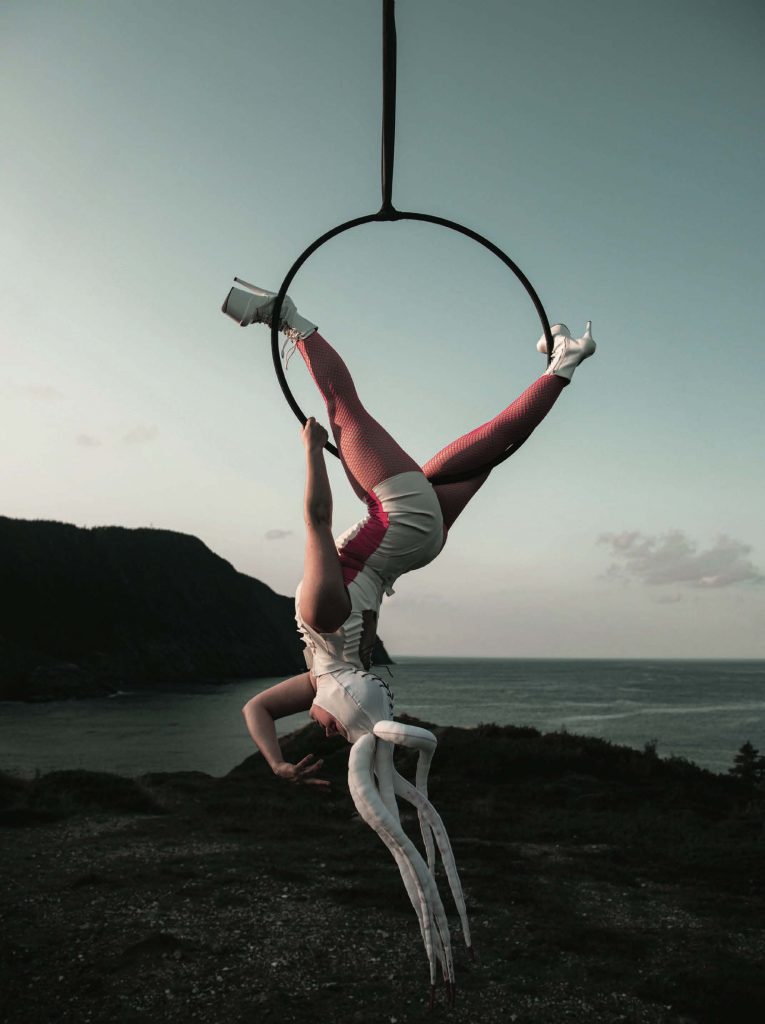
“There’s an appetite for the bizarre when it’s authentic, and you don’t learn that until you do the big brave thing and you be extremely strange and people respond to it. You can’t find out people are going to react positively without doing the big brave thing. Which, strange or not, drag is a big brave thing that people are out here doing,” they say. Backslash is carving their own strange path in the St. John’s scene, constantly training in contortion and aerial circus to present something entirely their own on the stages they slither across. Seeing the way they work with other members of the community and hold space for folks of all genders and presentations is frankly inspiring. If \garbagefile can do their own thing, their own drag in Newfoundland, then I certainly can too.
Miss Di Agnosed
In terms of big brave things, my next steps in Corner Brook were exactly that. I travelled seven hours for a drag show, so I guess it was time to put on a show 10 minutes from my home. I reached out to Josh Connors, a local Queer playwright and performer with a budding drag alter ego, and pitched a show to them. We originally planned a Valentine’s Day show that was derailed by the aforementioned lockdown and finally settled on two shows, April 23 and 24, just in time for my four-year burlesque anniversary and 27th birthday (I was 25 when the pandemic started. I don’t want to talk about it).
Connors and I wanted a cast of kings, queens, burlesque performers and beyond, and we got just that. “When I do anything Queer, it’s terrifying, especially in small towns where maybe the views are not as liberal, open-minded.… I do it ’cause I know there’s other Queer confused kids like I was in these small communities who are looking for places to feel safe and feel seen,” says Connors. Originally from Labrador, they spent a stint in Toronto where they studied musical theatre and eventually relocated to Corner Brook a couple years before the pandemic. Though they never planned to keep looking for arts work in the small town, arts work kept finding them.
“As someone who lived in a bigger centre, searching for that artistic goal, something tangible to be like ‘I’ve made it, I’m successful’ … I have now done more art, more Queer art, living in Newfoundland in the last three years, including a year and a half in a pandemic, than I did in my eight or nine years in Toronto,” they say. Connors created their drag persona, Miss Di Agnosed, while living in Corner Brook. Miss Di emerged from Connors’ open and very real struggles with mental health. Miss Di Agnosed is a place for them to put this on display and make Queer art about it. Connors cited the pandemic as a time when they were forced to stay home but allowed space to focus on their craft, and when they finally had the opportunity to bring it to a stage, the community had their back.
“Even though these art forms are very specific to the Queer community, to Queer people, there’s still been such an outpouring of support from the community,” they say. “Some people may not necessarily understand what you’re doing but they still want to help. That’s a really beautiful thing that I have found about creating these works on the west coast of Newfoundland.” Connors helped me perform my unapologetically Queer work in my hometown for the first time and continually shows me it has a place in Corner Brook. The pandemic created an influx of artists moving out of bigger centres or even moving home. It’s normal to have a room or bar full of Queer people in Toronto. But on the west coast of Newfoundland, having six Queer people in a room, and onstage, is pretty special.
Shea Muah
Speaking of radical Queer art inspired by mental health, drag queen Shea Muah’s persona emerged from letting go. Through grief, loss, rejection and a diagnosis of bipolar disorder, Scott Tobin was able to reconnect with his performing roots and let go of others’ perceptions to dive into drag. Originally from Stephenville, N.L., Tobin is trained in French and education. Feeling stagnant in his field, he took a stab at applying to medical school but was rejected, quickly learning that loss was a space for freedom and no longer needing to hide. Tobin remembers seeing the sixth season of RuPaul’s Drag Race where Seattle queen BenDeLaCreme competed. DeLa was known for presenting a fully realized character in drag while also talking openly about loss, body struggles and mental health.
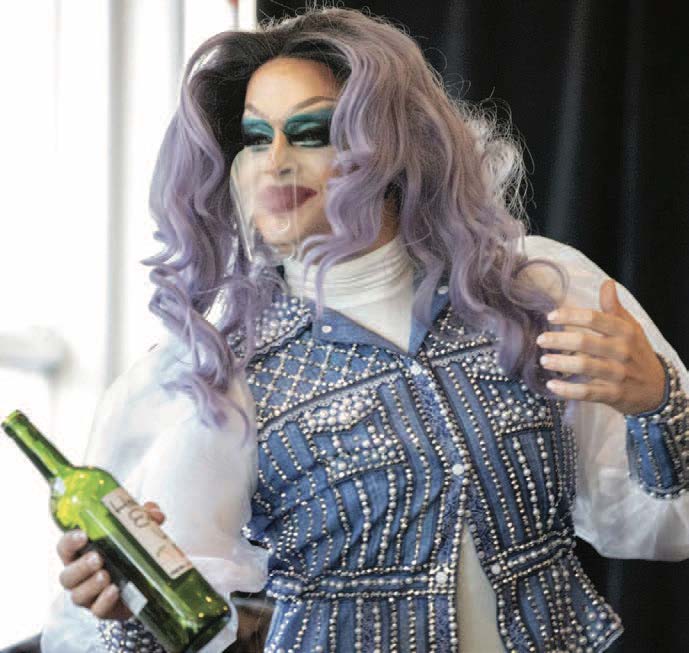
Witnessing BenDeLaCreme, Tobin realized how validating it is to witness someone you can identify with in the media. In terms of making platforms and making drag visible, he’s done this in places I never imagined drag would exist. Alongside Fashionista Jones and Misty, two St. John’s queens with roots on the west coast of the island, Muah brought two full theatrical drag shows in 2021 to the Arts and Culture Centre in Stephenville. People from the community talked about the shows for months. Amidst a pandemic, Muah was able to bring drag to areas of the island that potentially had never seen it, still with care and safety in mind. What Muah brings to the stage is theatricality, emotion and an indescribable energy. She brings you French music, musical theatre and an absolute commitment to her character. She shows me, and everyone else, you get to do drag your own way. Muah is currently on what Tobin is calling a “Hi-Shea-tus” while he completes a master’s program in speech language pathology at University of Ottawa. I like to think she’s just on sabbatical and I’ll see her light up a stage again soon.
Muah was the first queen Bardot saw perform when she moved to St. John’s. Muah was performing Rose’s Turn, and Bardot yelled from the audience, “Whose version are you doing?” Of course, it was Bette Midler’s, coincidentally the first song Bardot had ever performed in drag. Bardot went on to perform that song for Muah at her going-away show. Visibility, seeing someone with your references and interests, keeps people inspired and feeling like they belong. Connecting with Muah was part of Bardot’s journey into drag in Newfoundland. Another queen making waves in the St. John’s drag scene who witnessed Muah on her first night out in St. John’s was Larinda Mood.
Larinda Mood
Larinda Mood wants you to know first and foremost that she is Black and taking up space. Newfoundland has never been a kind place for visibly racialized folks, and our drag scene can unfortunately reflect that. Currently, we have two active drag performers of colour in the entire province. That is an issue that Mood is full-force working on; she is producing a Black History Month show in February. She says, “Drag came from my Queerness.” Integral to her art are influences like Mary J. Blige, Whitney Houston and Billie Holiday, as well as references to strong Black women and Black Excellence. Mood is the queen of stand and deliver. Her movement choices are subtle but effective. She emotes, she connects and she puts on a show. Originally from St. Catharines, Ont., she moved to Newfoundland with her now husband not long before the pandemic.
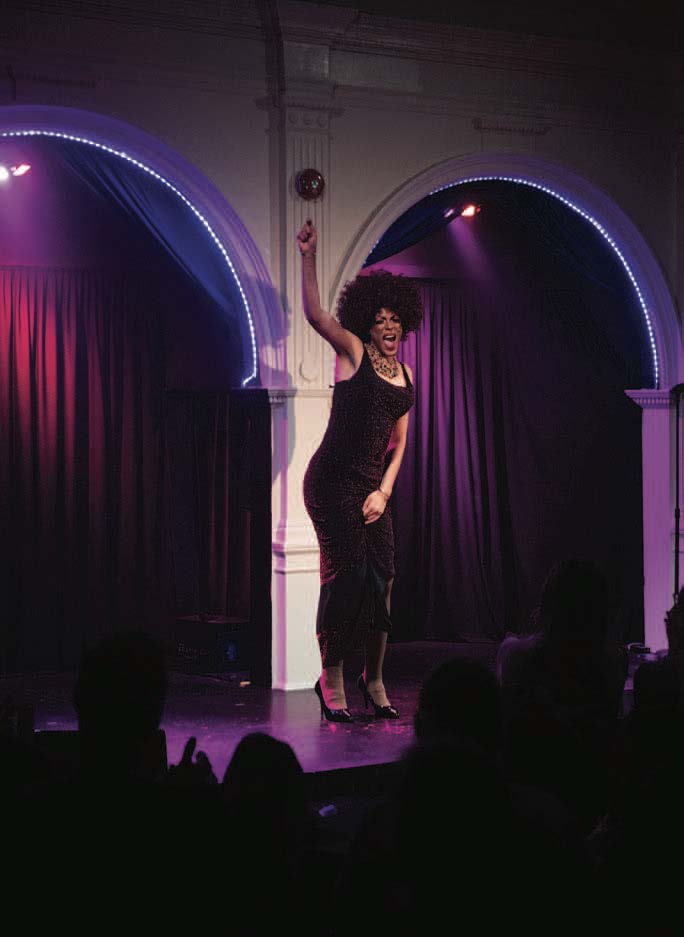
When she moved here, she asked her partner, “How many Black people do you see? How many Queer people do you see?” Visibility was severely lacking. So in the theme of doing the big brave thing, Mood became that visibility. She dove into drag and quickly began producing shows inspired by her life and by Black culture, hosting a ball-themed show and an event called Beyoncé… A Night of Lemonade. Two out of the four entertainers that night were BIPOC: Larinda herself and Sasha Doll, a 19-year-old drag queen and immigrant to Newfoundland from the Philippines. Just like six Queer people sharing a stage in Corner Brook is actually a large number, two visibly BIPOC drag queens performing in the same show is a large number for St. John’s. But two is far from enough. “It’s not only the fact that non-POC need to have the conversation; they need to have the conversation for themselves rather than speak for us. We have our own voice; you don’t need to be my voice. It needs to be your turn to vocalize how you’re feeling and what you’re thinking and ask for the education rather than try to educate when you aren’t educated,” she says. While I’m calling for visibility on a national level, it’s important to recognize where we’re lacking locally. The lack of visibility for BIPOC drag performers in Newfoundland is evident, and if you don’t see yourself represented on a stage in a Queer space, how do you know that space is for you as well? How do you know you can be that representation? Mood is constantly teaching me that the work is far from done, that white discomfort is a privilege and that dismantling and dissecting the prejudices of my home is work I can constantly be doing.
Newfound Lad, Newfound Identity
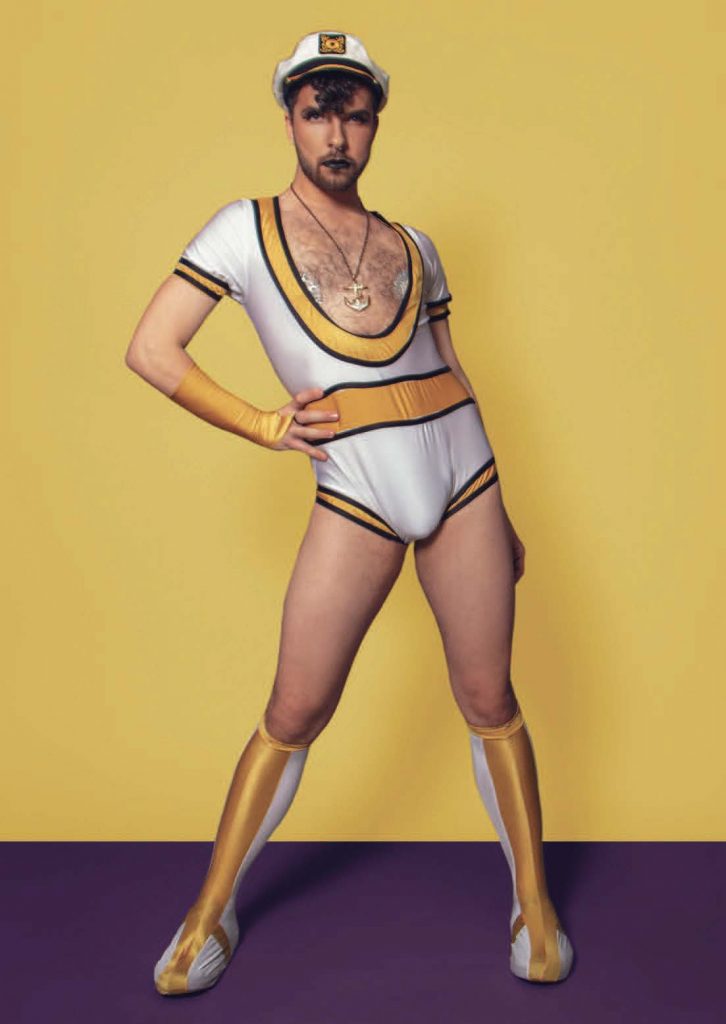
My journey home to Newfoundland has been unexpected in so many ways. I’ve been here for more than a year – the longest consecutive time I’ve spent living in this province since I was 19. I ended up performing burlesque in my hometown last April, with my supportive father in the front row smiling and laughing while watching his son do ridiculous and questionable things onstage. In July, I made the move to St. John’s, smack dab in the middle of Pride month. I did shows with Bardot, Muah and Mood and got to know \garbagefile in person. I was transforming as a burlesque artist into a little more than just drag adjacent, inspired and influenced by the work I was seeing around me. I’m learning new things about makeup, lip-synching, who Newfound Lad is and what I want to present onstage in my community. I’m doing things I love in Newfoundland, something I never thought I would do. I’m seeing amazing, diverse art in Newfoundland, something I was taught you had to go away to see. I’m being unapologetically Queer in Newfoundland.
All this is during a pandemic, and this community has been able to experience growth beyond expectations. “I think the country is looking in the wrong direction when it comes to drag,” says Muah, words that ring true to me. I’m from here and I couldn’t see the value of the Queer art here until I witnessed it and immersed myself in it. Here I am, an artist who had to leave for eight years only to learn so much more about myself upon returning, saying, “Look over here!” Look at what artists from smaller places across this country are doing and tell me it’s not worthy of an international platform. I think it’s high time the drag happening here on the East Coast gets a shot on the biggest stage because the work is good; it just needs to be seen. Give us that visibility, by’s, and we’ll put on one hell of a show.
***
Sommaire
Josh Murphy est un performeur burlesque et se considère comme adjacent au drag ; on le trouve souvent à proximité d’un·e artiste drag. Avant de se joindre à la troupe burlesque torontoise Boylesque TO, Murphy pensait devenir drag queen, mais il n’était pas doué en maquillage et manquait d’intérêt pour se perfectionner. Il a rapidement appris que le maquillage et le costume sont tout aussi importants au burlesque qu’au drag. Dans une quête de professionnalisation, il s’inscrit au Absolut Empire’s Ball, une compétition inclusive d’équipes de drag créée par Scarlett Bobo, finaliste à la première saison de Canada’s Drag Race. L’équipe de Murphy, Rebel Gen, gagne. Après, il commence à accéder à un autre palier d’évènements burlesque et se trouve dans les marges du drag. Ensuite, il y a eu mars 2020 et la COVID-19. Murphy décide de retourner dans son territoire natal à Terre-Neuve-et-Labrador. « Partir en tournée au Canada m’a appris que le drag, le burlesque et l’art queer peuvent se manifester n’importe où », écrit Murphy. « J’ai alors entrepris d’être témoin des pratiques à Terre-Neuve-et-Labrador, et de voir ce qui est exclu du “sommet du drag” d’un océan à l’autre. Je veux connaitre le drag pratiquée par ces artistes, voir c’est quoi de performer le drag ici et, j’espère, en apprendre plus sur ma propre pratique en cours de route. »
Dance Media Group strengthens the dance sector through dialogue. Can you help us sustain national, accessible dance coverage? Your contribution supports writers, illustrators, photographers and dancers as they tell their own stories. Dance Media Group is a charitable non-profit organization publishing The Dance Current in print and online.

Tagged: Atlantic Canada , Newfoundland and Labrador

